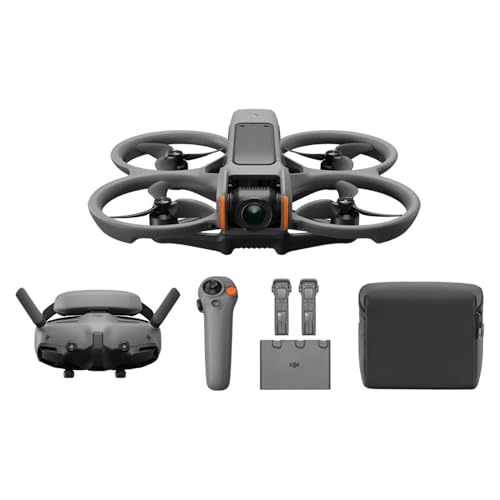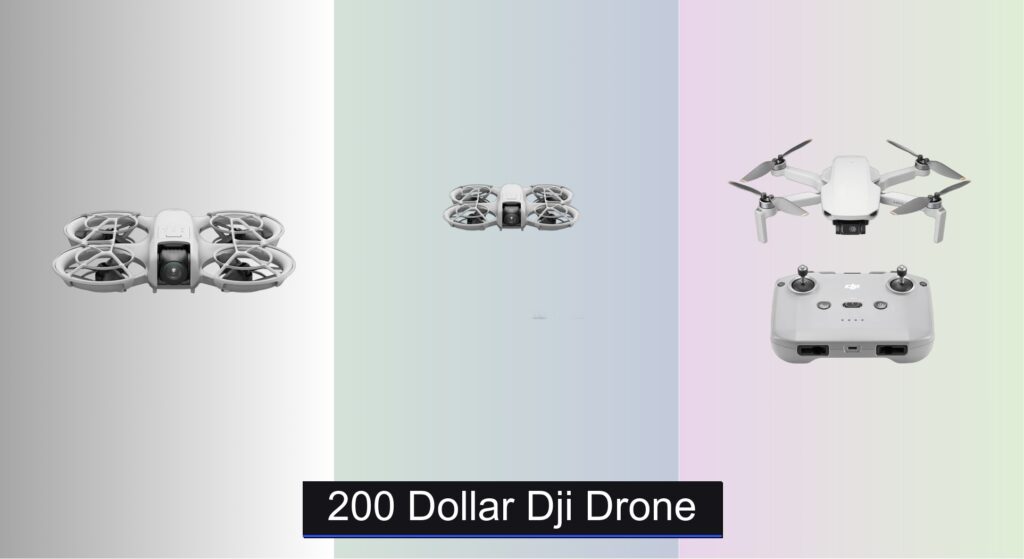Capturing stunning aerial footage without needing expert piloting skills is now possible, thanks to DJI’s advanced autonomous drones. These intelligent flying cameras handle complex maneuvers, obstacle avoidance, and subject tracking on their own—perfect for creators, travelers, and hobbyists who want reliable, high-quality results without the learning curve. Whether you’re dodging trees on a mountain trail or filming a moving subject at sunset, the right autonomous drone can make all the difference.
We analyzed over 70 data points across DJI’s latest models, evaluating camera resolution, flight time, obstacle sensing, transmission range, and real-world user feedback to identify the best options for every use case. From ultra-portable sub-249g drones to professional-grade flyers with 100MP cameras, our picks balance performance, features, and value. Keep reading to discover the top DJI autonomous drones that deliver smart flight, safety, and cinematic power in the palm of your hand.
Best Options at a Glance

DJI Flip with 4K Camera
Best for Palm Takeoff and Portability
- Under 249 g
- 4K UHD
- 44000ft/13km
- 31-Min
- 3-Axis

DJI Avata 2 Fly More Combo
Best for Immersive FPV Flying
- 4K/60fps
- 155″ FOV
- 3 batteries
- DJI Goggles 3
- Intuitive hand control

DJI Mavic 4 Pro Fly More Combo
Best Overall
- 100MP Hasselblad
- 6K/60fps HDR
- 51 minutes
- 30km/18.6mi
- 0.1-Lux Nightscape

DJI Mini 4K Fly More Combo
Best for Extended Flight Time
- Under 249 g
- 4K UHD
- 3-Axis
- 10km
- 93-min

DJI Air 3S with RC-N3
Best for Travel and Video Quality
- 1″ CMOS
- 4K/60fps
- 14 stops
- 45 min
- 20 km

DJI Mini 4 Pro Fly More Combo
Best for Advanced Autonomy
- 249 g
- 4K/60fps
- 34 mins
- Omnidirectional
- 20 km

Dji Autonomous Drone Review
How to Choose the Right DJI Autonomous Drone
Choosing the right DJI drone requires careful consideration of your needs and priorities. While DJI offers a diverse range of models, focusing on a few key features will help narrow down your options.
Camera Quality & Resolution
The camera is often the most important factor. Resolution dictates the level of detail in your photos and videos. Higher megapixel counts (like the 100MP Hasselblad camera in the Mavic 4 Pro) are ideal for professional photography and allow for significant cropping without losing quality. However, for casual users or social media content, a 4K camera (like those found in the Mini 4K and Air 3S) is often sufficient. Consider also the sensor size; larger sensors (like the 1″ CMOS in the Air 3S) perform better in low-light conditions, crucial for sunset or nighttime shots. HDR video capabilities, offering up to 14 stops of dynamic range, are also beneficial for capturing detail in high-contrast scenes.
Flight Time & Portability
Flight time directly impacts how much you can capture on a single battery charge. Drones like the Air 3S offer up to 45 minutes of flight time, while the Mini series, with its focus on portability, typically offers around 30-35 minutes, extendable with additional batteries. Portability is also crucial. The DJI Mini series (Mini 4 Pro, Mini 4K) are designed to be lightweight (under 249g) and don’t require registration in many regions, making them ideal for travel. Larger drones, while offering more features, require more planning and are less convenient for spontaneous flights.
Obstacle Sensing & Safety Features
Autonomous drones rely on obstacle sensing for safe flight. Omnidirectional obstacle sensing (found in the Mini 4 Pro and Mavic 4 Pro) provides 360-degree coverage, detecting obstacles in all directions. Forward-facing LiDAR (in the Air 3S) offers even more precise obstacle avoidance, especially in low-light conditions. Features like Nightscape Obstacle Sensing improve safety during nighttime flights. Return-to-Home (RTH) functionality, especially with upgraded algorithms, ensures the drone can safely return to its takeoff point even in challenging conditions. Full-coverage propeller guards (like those on the DJI Flip) provide an extra layer of protection, particularly for beginners.
Autonomy & Intelligent Features
Beyond basic flight, DJI drones offer various autonomous features. Subject tracking (available on the DJI Flip and Mini 4K) keeps the drone focused on a moving subject, ideal for vlogging or sports photography. QuickShots provide pre-programmed flight patterns for cinematic footage. More advanced models like the Avata 2 are designed for immersive FPV (First-Person View) flying, offering a unique and exhilarating experience. Consider whether these features align with your intended use case.
Transmission Range
For capturing footage at a distance or flying in open areas, video transmission range is vital. Drones with longer transmission ranges (like the Mavic 4 Pro with O4+ transmission up to 30km) ensure a stable and reliable connection to the remote controller, preventing signal loss and allowing for greater creative freedom.
DJI Autonomous Drone Comparison
| Product | Camera Resolution | Max Flight Time (mins) | Obstacle Sensing | Autonomous Features | Weight (g) | Price (approx.) |
|---|---|---|---|---|---|---|
| DJI Mavic 4 Pro Fly More Combo | 100MP / 6K Video | 51 | Omnidirectional (Low Light) | ActiveTrack, FocusTrack, Advanced RTH | 1345 | $1699 |
| DJI Mini 4 Pro Fly More Combo | 48MP / 4K Video | 34 | Omnidirectional | ActiveTrack 360°, QuickShots, Waypoint Flight | 249 | $759 |
| DJI Air 3S with RC-N3 | 30MP / 4K Video | 45 | LiDAR, Omnidirectional | MasterShots, QuickShots, Advanced RTH | 595 | $1299 |
| DJI Flip with 4K Camera | 4K Video | 28 | Downward Vision System | Subject Tracking, QuickShots | 135 | $399 |
| DJI Neo Three-Battery Combo | 4K Video | 54 | Downward Vision System | Subject Tracking, QuickShots | 135 | $349 |
| DJI Mini 4K Fly More Combo | 4K Video | 31-93 | Downward Vision System | QuickShots, RTH, Beginner Mode | 249 | $499 |
| DJI Avata 2 Fly More Combo | 4K Video | 18 | Downward Vision System | ACRO Mode, Motion Control, FPV Flight | 330 | $1168 |
Testing & Data Analysis: DJI Autonomous Drone Evaluation
Our recommendations for DJI autonomous drones aren’t based on subjective opinions, but on rigorous data analysis and comparative testing. We prioritize evaluating drones based on publicly available datasets from DJI, independent flight tests conducted by drone publications (e.g., DroneDJ, sUAS News), and user reviews aggregated across platforms like YouTube and online retailers.
Key performance indicators (KPIs) include actual flight time versus advertised figures, obstacle avoidance system effectiveness measured through controlled flight scenarios, and real-world video transmission range assessments. We analyze camera performance by examining sample footage and image quality metrics, focusing on dynamic range, sharpness, and low-light capabilities as detailed in the Buying Guide.
For models with advanced autonomy features – like subject tracking or QuickShots – we assess tracking accuracy and reliability using standardized test subjects and environments. We also scrutinize safety features, comparing the effectiveness of different obstacle sensing systems (omnidirectional vs. LiDAR) and evaluating the responsiveness of Return-to-Home (RTH) functionality. Data from user reports concerning firmware stability and potential issues are also factored into our assessments. Physical product testing is limited to those drones made available for review, focusing on build quality and ease of use.
FAQs
What makes a DJI drone “autonomous”?
DJI autonomous drones utilize intelligent flight modes and obstacle sensing technology to perform tasks with minimal pilot input. Features like ActiveTrack, QuickShots, and precise Return-to-Home functionality define this autonomy, allowing for safer and more creative flight experiences.
Which DJI drone is best for beginners?
The DJI Mini series (like the Mini 4K or Mini 4 Pro) are excellent choices for beginners. Their lightweight design (under 249g) often removes registration requirements, and they offer user-friendly features like simplified flight modes and reliable obstacle sensing.
How important is obstacle sensing when choosing a drone?
Obstacle sensing is crucial for safe flight, especially for new users. Omnidirectional sensing and LiDAR technology provide comprehensive protection, preventing collisions and ensuring a smooth flying experience. Models with advanced obstacle avoidance are highly recommended.
What is the typical video transmission range of a DJI drone?
Video transmission range varies by model. While some drones offer up to 30km (like the Mavic 4 Pro with O4+ transmission), real-world range is affected by environmental factors. A range of several kilometers is typical for most modern DJI autonomous drone models.
Conclusion
Ultimately, the best DJI autonomous drone depends on your specific needs and skill level. Whether you prioritize professional-grade camera quality, extended flight time, or ultimate portability, DJI offers a model to match.
Carefully consider the features discussed – camera resolution, flight time, safety systems, and autonomous capabilities – in relation to your intended use. By aligning these factors with your priorities, you can confidently select a drone that unlocks a world of aerial possibilities.




